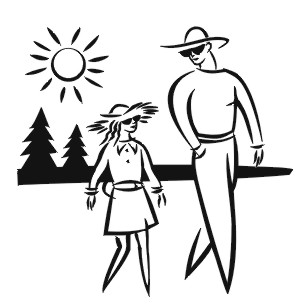Sun Safety Tips
These sun safety tips are very useful for protecting your skin from the sun’s damaging rays. Sun Safety means using all sun-safe tips together for maximum protection from the Sun’s harmful UV rays. Skin protection from the sun’s harmful rays is vital for a number of important health reasons. The most common cause of skin cancer is sun damage. Ultraviolet rays from the sun cause tanning and burning. Tanned skin is damaged skin, which can lead to dryness, wrinkles, brown spots, and skin cancer.
Protect Yourself and Your Family Year-Round from harmful Sun Radiations

Sun Safety Tips
- Seek the shade, especially during the sun’s peak hours (10:00 am - 4:00 pm). the shade, especially during the sun’s peak hours (10:00 am - 4:00 pm). >
- Always wear a broad-spectrum sunscreen with a sun protection factor (SPF) of 15 or higher. Sun damage occurs even on cloudy days.
- Cover up with clothing, especially a broad-brimmed hat and UV-blocking sunglasses. Use long sleeve rash guards with a high SPF rating if you are on the beach or in the water.
- Avoid tanning parlors and artificial tanning devices.
- Get vitamin D safely through a healthy diet that includes vitamin supplements.
- Keep newborns out of the sun. Sunscreens can be used on babies over the age of six months.
- Check with your doctor to be sure.
- Teach children good sun-protective practices.
- Examine your skin from head to toe once every month.
- Have a professional medical examination annually.
- Avoid tanning and especially do not burn! One blistering sunburn can double your risk of melanoma.
- Overexposure to the sun’s ultraviolet (UV) rays can seriously threaten you and your family's health. Besides the immediate effect of sunburn, long-term exposure to excess UV radiation can cause skin cancer, eye damage, immune system suppression, and premature aging.
- Children are highly susceptible to harmful UV radiation. Approximately 23 percent of lifetime sun exposure occurs before the age of 18. Just one or two blistering sunburns in childhood can double the risk of developing melanoma.
- Teaching children about sun safety is the key to reducing the risk of future health problems.
How to Choose a Sunscreen
- Choose a sunscreen with an SPF factor of 15 or higher that also blocks the full spectrum of UVA light. SPF ratings tell you how well the sunscreen shields against UVA rays that burn and damage the skin.
- Avoid products that combine UV and insect protection in one bottle. The sunscreen may be less effective.
- Oil-free products are best for you if you get acne breakouts.
- If sunscreen causes stinging, itching, or a rash, try a fragrance-free formula.
- Cosmetics, moisturizer, or make-up foundations with UV protection need a full teaspoon of the product on your face to provide good protection.
- Keep babies younger than 6 months out of the sun. Use sunscreen made for babies but limit the time in the sun.
How to Use Sunscreen
- Apply sunscreen at least 20 minutes before going outside.
- Use enough sunscreen to cover your body well. Do not forget to apply sunscreen to the nose, neck, tops of feet, rims of ears, and the lips.
- Reapply sunscreen every 2 hours when outdoors, even if the label says the sunscreen is water-resistant, sweat-proof, or all-day protection. Put on more sunscreen when it is windy, after being in the water, or after working up a sweat.
- Do not use expired sunscreen lotion.
These sum safety tips works a lot to my skin. Now I never worry about my skin whenever I go out. Thank you very much for sharing these sun safety tips.